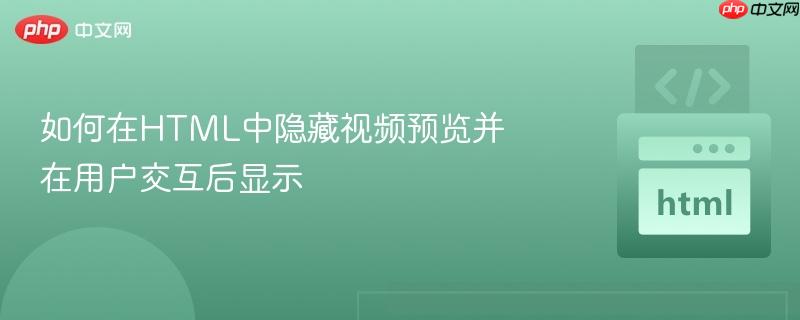
在网页开发中,我们经常需要在特定用户操作(例如点击按钮)之后才显示视频内容,而不是在页面加载时就显示视频预览。这不仅能让页面布局更整洁,还能避免不必要的资源加载,提升用户体验。本文将详细讲解如何通过HTML、CSS和JavaScript协同工作,实现这一功能。
实现视频按需显示的核心思想是:
我们将主要利用CSS的display属性和JavaScript的DOM操作来实现。
首先,我们需要一个视频元素和一个触发显示的按钮。视频元素需要一个唯一的id以便JavaScript进行操作。
立即学习“前端免费学习笔记(深入)”;
<!DOCTYPE html>
<html lang="zh-CN">
<head>
<meta charset="UTF-8">
<meta name="viewport" content="width=device-width, initial-scale=1.0">
<title>按需显示视频教程</title>
<style>
/* 简单样式,使页面更美观 */
body {
font-family: Arial, sans-serif;
margin: 20px;
text-align: center;
}
#video-container {
margin-top: 20px;
}
button {
padding: 10px 20px;
font-size: 16px;
cursor: pointer;
background-color: #007bff;
color: white;
border: none;
border-radius: 5px;
transition: background-color 0.3s ease;
}
button:hover {
background-color: #0056b3;
}
</style>
</head>
<body>
<h1>点击按钮播放视频</h1>
<button id="showVideoButton">点击显示视频</button>
<div id="video-container">
<!-- 视频元素,初始状态通过CSS隐藏 -->
<video id="myVideo" width="640" height="360" controls>
<source src="your-video.mp4" type="video/mp4">
<source src="your-video.webm" type="video/webm">
您的浏览器不支持HTML5视频。
</video>
</div>
<script>
// JavaScript 代码将在此处添加
</script>
</body>
</html>请将your-video.mp4和your-video.webm替换为你的实际视频文件路径。
在HTML的
标签内或外部CSS文件中,为视频元素添加display: none;样式,使其在页面加载时不可见。<style>
/* ... 其他样式 ... */
#myVideo {
display: none; /* 初始隐藏视频 */
}
</style>或者,你也可以直接在视频标签内使用行内样式:
<video id="myVideo" width="640" height="360" controls style="display: none;">
<!-- ... 视频源 ... -->
</video>推荐使用内联样式或在
现在,我们需要编写JavaScript代码来监听按钮的点击事件,并在事件发生时将视频显示出来。
在
标签结束前,添加以下JavaScript代码: <script>
// 获取按钮和视频元素
const showVideoButton = document.getElementById('showVideoButton');
const myVideo = document.getElementById('myVideo');
// 为按钮添加点击事件监听器
showVideoButton.addEventListener('click', function() {
// 将视频的display属性从'none'改为'block',使其可见
myVideo.style.display = 'block';
// 可选:如果希望视频在显示后立即自动播放
// myVideo.play();
// 可选:如果希望按钮在视频显示后消失
// this.style.display = 'none';
});
</script>
</body>
</html>结合上述所有部分,一个完整的示例代码如下:
<!DOCTYPE html>
<html lang="zh-CN">
<head>
<meta charset="UTF-8">
<meta name="viewport" content="width=device-width, initial-scale=1.0">
<title>按需显示视频教程</title>
<style>
body {
font-family: Arial, sans-serif;
margin: 20px;
text-align: center;
}
#video-container {
margin-top: 20px;
}
button {
padding: 10px 20px;
font-size: 16px;
cursor: pointer;
background-color: #007bff;
color: white;
border: none;
border-radius: 5px;
transition: background-color 0.3s ease;
}
button:hover {
background-color: #0056b3;
}
/* 初始隐藏视频 */
#myVideo {
display: none;
}
</style>
</head>
<body>
<h1>点击按钮播放视频</h1>
<button id="showVideoButton">点击显示视频</button>
<div id="video-container">
<video id="myVideo" width="640" height="360" controls>
<!-- 替换为你的视频文件路径 -->
<source src="https://www.w3schools.com/html/mov_bbb.mp4" type="video/mp4">
<source src="https://www.w3schools.com/html/mov_bbb.ogg" type="video/ogg">
您的浏览器不支持HTML5视频。
</video>
</div>
<script>
const showVideoButton = document.getElementById('showVideoButton');
const myVideo = document.getElementById('myVideo');
showVideoButton.addEventListener('click', function() {
myVideo.style.display = 'block'; // 显示视频
// 可选:立即播放视频
// myVideo.play();
// 可选:隐藏按钮
// this.style.display = 'none';
});
</script>
</body>
</html>视频预加载(preload属性):
用户体验:
可访问性:
替代隐藏方法:
通过结合CSS的display: none和JavaScript的DOM操作,我们可以轻松实现HTML视频的按需显示功能。这种方法不仅能让页面布局更灵活,还能有效控制视频资源的加载时机,从而优化网页性能和用户体验。在实际应用中,请根据具体需求考虑视频预加载策略、用户体验细节和可访问性。
以上就是如何在HTML中隐藏视频预览并在用户交互后显示的详细内容,更多请关注php中文网其它相关文章!

HTML怎么学习?HTML怎么入门?HTML在哪学?HTML怎么学才快?不用担心,这里为大家提供了HTML速学教程(入门课程),有需要的小伙伴保存下载就能学习啦!

Copyright 2014-2025 https://www.php.cn/ All Rights Reserved | php.cn | 湘ICP备2023035733号